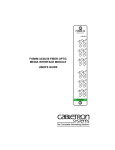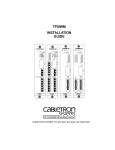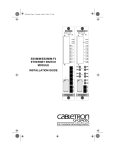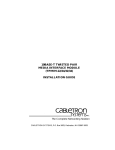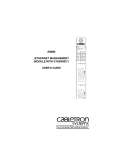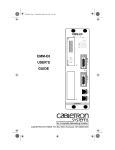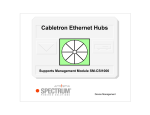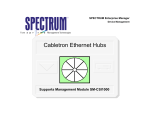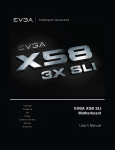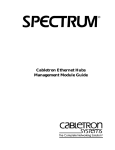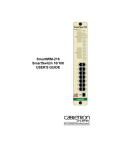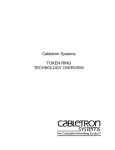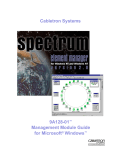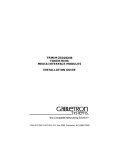Download Enterasys (FORMIM
Transcript
REPEATER MEDIA INTERFACE MODULES (TPRMIM/FORMIM/CXRMIM) INSTALLATION GUIDE CABLETRON SYSTEMS, P. O. Box 5005, Rochester, NH 03866-5005 Notice NOTICE Cabletron Systems reserves the right to make changes in specifications and other information contained in this document without prior notice. The reader should in all cases consult Cabletron Systems to determine whether any such changes have been made. The hardware, firmware, or software described in this manual is subject to change without notice. IN NO EVENT SHALL CABLETRON SYSTEMS BE LIABLE FOR ANY INCIDENTAL, INDIRECT, SPECIAL, OR CONSEQUENTIAL DAMAGES WHATSOEVER (INCLUDING BUT NOT LIMITED TO LOST PROFITS) ARISING OUT OF OR RELATED TO THIS MANUAL OR THE INFORMATION CONTAINED IN IT, EVEN IF CABLETRON SYSTEMS HAS BEEN ADVISED OF, KNOWN, OR SHOULD HAVE KNOWN, THE POSSIBILITY OF SUCH DAMAGES. © Copyright 1994 by: Cabletron Systems, Inc. P.O. Box 5005, Rochester, NH 03866-5005 All Rights Reserved Printed in the United States of America Order number: 9030679-02 October 94 Remote LANVIEW, LANVIEW, Multi Media Access Center and SPECTRUM are registered trademarks of Cabletron Systems, Inc. EMME, EMM-E6, RMIM, CXRMIM, TPRMIM, FORMIM, EPIM-A, EPIM-X, EPIM-F, EPIM-T, MMAC-3FNB, MMAC-5FNB, MMAC-8FNB, MMAC-M8FNB, IRM, IRM2, IRM3, and IRBM are trademarks of Cabletron Systems, Inc. Windows is a registered trademark of Microsoft Corporation. CompuServe is a registered trademark of CompuServe, Inc. UNIX is a registered trademark of UNIX System Laboratories, Inc. Printed On Installation Guide Recycled Paper i Notice FCC NOTICE This device complies with Part 15 of the FCC rules. Operation is subject to the following two conditions: (1) this device may not cause harmful interference, and (2) this device must accept any interference received, including interference that may cause undesired operation. NOTE: This equipment has been tested and found to comply with the limits for a Class A digital device, pursuant to Part 15 of the FCC rules. These limits are designed to provide reasonable protection against harmful interference when the equipment is operated in a commercial environment. This equipment uses, generates, and can radiate radio frequency energy and if not installed in accordance with the operator’s manual, may cause harmful interference to radio communications. Operation of this equipment in a residential area is likely to cause interference in which case the user will be required to correct the interference at his own expense. WARNING: Changes or modifications made to this device which are not expressly approved by the party responsible for compliance could void the user’s authority to operate the equipment. DOC NOTICE This digital apparatus does not exceed the Class A limits for radio noise emissions from digital apparatus set out in the Radio Interference Regulations of the Canadian Department of Communications. Le présent appareil numérique n’émet pas de bruits radioélectriques dépassant les limites applicables aux appareils numériques de la class A prescrites dans le Règlement sur le brouillage radioélectrique édicté par le ministère des Communications du Canada. CABLETRON SYSTEMS, INC. PROGRAM LICENSE AGREEMENT IMPORTANT: Before utilizing this product, carefully read this License Agreement. This document is an agreement between you, the end user, and Cabletron Systems, Inc. (“Cabletron”) that sets forth your rights and obligations with respect to the Cabletron software program (the “Program”) contained in this package. The Program may be contained in firmware, chips or other media. BY UTILIZING THE ENCLOSED PRODUCT, YOU ARE AGREEING TO BECOME BOUND BY THE TERMS OF THIS AGREEMENT, WHICH INCLUDES THE LICENSE AND THE LIMITATION OF WARRANTY AND DISCLAIMER OF LIABILITY. IF YOU DO NOT AGREE TO THE TERMS OF THIS AGREEMENT, PROMPTLY RETURN THE UNUSED PRODUCT TO THE PLACE OF PURCHASE FOR A FULL REFUND. ii Repeater MIM Notice CABLETRON SOFTWARE PROGRAM LICENSE 1. LICENSE. You have the right to use only the one (1) copy of the Program provided in this package subject to the terms and conditions of this License Agreement. You may not copy, reproduce or transmit any part of the Program except as permitted by the Copyright Act of the United States or as authorized in writing by Cabletron. 2. OTHER RESTRICTIONS. Program. You may not reverse engineer, decompile, or disassemble the 3. APPLICABLE LAW. This License Agreement shall be interpreted and governed under the laws and in the state and federal courts of New Hampshire. You accept the personal jurisdiction and venue of the New Hampshire courts. EXCLUSION OF WARRANTY AND DISCLAIMER OF LIABILITY 1. EXCLUSION OF WARRANTY. Except as may be specifically provided by Cabletron in writing, Cabletron makes no warranty, expressed or implied, concerning the Program (including Its documentation and media). CABLETRON DISCLAIMS ALL WARRANTIES, OTHER THAN THOSE SUPPLIED TO YOU BY CABLETRON IN WRITING, EITHER EXPRESS OR IMPLIED, INCLUDING BUT NOT LIMITED TO IMPLIED WARRANTIES OF MERCHANTABLITY AND FITNESS FOR A PARTICULAR PURPOSE, WITH RESPECT TO THE PROGRAM, THE ACCOMPANYING WRITTEN MATERIALS, AND ANY ACCOMPANYING HARDWARE. 2. NO LIABILITY FOR CONSEQUENTIAL DAMAGES. IN NO EVENT SHALL CABLETRON OR ITS SUPPLIERS BE LIABLE FOR ANY DAMAGES WHATSOEVER (INCLUDING, WITHOUT LIMITATION, DAMAGES FOR LOSS OF BUSINESS, PROFITS, BUSINESS INTERRUPTION, LOSS OF BUSINESS INFORMATION, SPECIAL, INCIDENTAL, CONSEQUENTIAL, OR RELIANCE DAMAGES, OR OTHER LOSS) ARISING OUT OF THE USE OR INABILITY TO USE THIS CABLETRON PRODUCT, EVEN IF CABLETRON HAS BEEN ADVISED OF THE POSSIBILITY OF SUCH DAMAGES. BECAUSE SOME STATES DO NOT ALLOW THE EXCLUSION OR LIMITATION OF LIABILITY FOR CONSEQUENTIAL OR INCIDENTAL DAMAGES, OR ON THE DURATION OR LIMITATION OF IMPLIED WARRANTEES IN SOME INSTANCES THE ABOVE LIMITATIONS AND EXCLUSIONS MAY NOT APPLY TO YOU. Installation Guide iii Notice UNITED STATES GOVERNMENT RESTRICTED RIGHTS The enclosed product (a) was developed solely at private expense; (b) contains “restricted computer software” submitted with restricted rights in accordance with Section 52227-19 (a) through (d) of the Commercial Computer Software - Restricted Rights Clause and its successors, and (c) in all respects is proprietary data belonging to Cabletron and/or its suppliers. For Department of Defense units, the product is licensed with “Restricted Rights” as defined in the DoD Supplement to the Federal Acquisition Regulations, Section 52.227-7013 (c) (1) (ii) and its successors, and use, duplication, disclosure by the Government is subject to restrictions as set forth in subparagraph (c) (1) (ii) of the Rights in Technical Data and Computer Software clause at 252.2277013. Cabletron Systems, Inc., 35 Industrial Way, Rochester, New Hampshire 03867. SAFETY WARNING It is the responsibility of the person who sells the system to which the TPRMIM, FORMIM, CXRMIM or EPIMs will be a part to ensure that the total system meets allowed limits of conducted and radiated emissions. Designed in accordance with UL478, UL910, NEC 725-2(b), CSA, IEC, TUV, VDE Class A. Meets FCC Part 15, Class A limits. iv Repeater MIM CONTENTS CHAPTER 1 1.1 1.2 1.3 1.4 1.5 1.6 1.7 1.8 Using this Manual ........................................................................ 1-2 Getting Help................................................................................. 1-2 RMIM Overview ........................................................................... 1-3 RMIM Features............................................................................ 1-4 The Multimedia Access Centers with FNB .................................. 1-6 The EMME................................................................................... 1-6 The EMM-E6 ............................................................................... 1-8 Related Manuals.......................................................................... 1-9 CHAPTER 2 2.1 2.2 2.3 3.3 3.4 Installation Requirements and Specifications Network Cable Requirements...................................................... 2-1 2.1.1 10BASE-2 Thin-Net Network Requirements ................. 2-1 2.1.2 10BASE-T Twisted Pair Network Requirements ........... 2-2 2.1.3 FOIRL/10BASE-FL Multimode Fiber Optic Network Requirements for the FORMIM ....................... 2-4 2.1.4 FOIRL/10BASE-FL Single Mode Fiber Optic Network Requirements for the FORMIM ....................... 2-5 2.1.5 Transceiver/AUI Requirements for the TPRMIM-36 ................................................................... 2-6 RMIM Network Port Specifications .............................................. 2-7 2.2.1 TPRMIM-20/22 RJ45 Connector Specifications ............ 2-7 2.2.2 TPRMIM-33/36 Champ Connector Specifications ......... 2-7 2.2.3 CXRMIM Coaxial Connector Specifications .................. 2-9 2.2.4 FORMIM-22, ST Connector Specifications ................... 2-9 Operating Specifications............................................................ 2-11 CHAPTER 3 3.1 3.2 Introduction Installing the RMIM Unpacking the RMIM ................................................................... 3-1 Setting the RMIM Jumpers for the CXRMIM, FORMIM and TPRMIM................................................................ 3-2 3.2.1 Setting the Ethernet Jumpers ........................................ 3-3 3.2.2 Setting the Unmanaged Module Group Jumper ............ 3-3 Installing the RMIM into the MMAC ............................................. 3-5 3.3.1 Installing an EPIM .......................................................... 3-7 Connecting the RMIM/EPIM to the Network................................ 3-9 3.4.1 Attaching Thin-Net Segments to the CXRMIM .............. 3-9 3.4.2 Connecting a Thin-Net Segment to an EPIM-C ........... 3-10 Installation Guide v Contents 3.4.3 3.4.4 3.4.5 3.4.6 3.4.7 CHAPTER 4 4.1 4.2 Attaching a Twisted Pair Segment to the TPRMIM-20/22 .............................................................3-12 Attaching a Twisted Pair Segment to the TPRMIM-33/36 .............................................................3-13 Connecting a Twisted Pair Segment to an EPIM-T .........................................................................3-14 Connecting a Fiber Optic Link Segment to a FORMIM, EPIM-F1, EPIM-F2, or EPIM-F3 ..................3-16 Connecting an AUI Cable to an EPIM-A or EPIM-X .....................................................................3-19 Testing the RMIMs Pre-Installation Test .....................................................................4-1 Installation Check-Out..................................................................4-2 APPENDIX A Twisted Pair Wiring Tables APPENDIX B EPIM Specifications INDEX vi Repeater MIM CHAPTER 1 INTRODUCTION Welcome to the Cabletron Systems’ Repeater Media Interface Module (RMIM™) Installation Guide. This manual is a reference guide for Cabletron’s family of RMIMs. These modules incorporate the Repeater Interface Controller (RIC). The RIC is a multi-port repeater that enables the RMIMs to autonomously repeat packets without channeling them to a repeater module. The following RMIMs incorporate RIC technology: • TPRMIM-20™ & TPRMIM-22™ – The TPRMIM-20 provides nine 10BASE-T RJ45 Unshielded Twisted Pair (UTP) ports and one slot for a Cabletron Systems Ethernet Port Interface Module (EPIM). The TPRMIM22 provides twenty-one 10BASE-T RJ45 UTP ports and one EPIM slot. • TPRMIM-33™ & TPRMIM-36™ – The TPRMIM-33 has one 50-pin champ connector providing twelve 10BASE-T twisted pair ports and one EPIM slot. The TPRMIM-36 has two 50-pin champ connectors providing twenty-four 10BASE-T twisted pair ports, one AUI connector, and one EPIM slot. • CXRMIM™ – The CXRMIM is equipped with twelve 10BASE-2 coaxial connectors and one EPIM slot. • FORMIM-22™ – The FORMIM-22 is equipped with twelve FOIRL/10BASE-FL ports with ST type connectors. NOTE This manual uses the term RMIM when describing features and functions that are common to the TPRMIM-20, TPRMIM-22, TPRMIM-33, TPRMIM-36, CXRMIM, and FORMIM-22. Installation Guide 1-1 Chapter 1: INTRODUCTION 1.1 USING THIS MANUAL Read this manual to gain a full understanding of the features and capabilities of the Cabletron Systems RMIMs. You should have a general working knowledge of Ethernet or IEEE 802.3 type data communications networks and their physical layer components before installing the RMIMs. Chapter 1, Introduction, discusses the contents of this manual, briefly describes capabilities and special features of the RMIMs, and concludes with a list of related manuals. Chapter 2, Installation Requirements/Specifications, describes installation requirements, network guidelines, and operating specifications for the RMIMs and EPIMs. Chapter 3, Installing the RMIM, contains instructions for setting the RMIM jumpers and installing the RMIMs into the MMAC/FNB. This chapter also explains how to connect network segments to the RMIMs and EPIMs. Chapter 4, Testing the RMIMs, provides procedures for testing and troubleshooting the installation of the RMIMs. It also explains how to use Cabletron Systems’ LANVIEW diagnostic and monitoring system. Appendix A, Twisted Pair Wiring Tables, contains wiring pinouts for Punchdown Block applications. Appendix B, EPIM Specifications, provides specifications and switch settings for the Ethernet Port Interface Modules (EPIMs). 1.2 GETTING HELP If you need additional support related to the Cabletron Systems RMIMs, or if you have any questions, comments, or suggestions concerning this manual, contact Cabletron Systems Technical Support: By phone .............................. (603) 332-9400 Monday-Friday; 8am - 8pm EST By CompuServe® ................. GO CTRON from any ! prompt By Internet mail ................... [email protected] 1-2 Repeater MIM RMIM OVERVIEW 1.3 RMIM OVERVIEW Cabletron Systems Repeater Media Interface Modules provide connections to 10BASE-T, 10BASE-2, and FOIRL/10BASE-FL based Ethernet networks. Figure 1-1 shows each module. RMIMs repeat, retime, and regenerate each packet ensuring data integrity and maximum data path distance. RMIMs also have a Fault Isolation feature that automatically segments problem ports from the network. When the problem port receives a good packet, the RMIM automatically reconnects the port to the network. FORMIM-22 RCV B B C CLN CLN CLN POK RCV 1 1 RX LNK RCV LNK 1 TX 8 2 RX RCV LNK RCV POK 6 7 8 9 10 RCV POK 2 3 4 5 6 7 8 9 10 11 12 13 15 16 17 18 19 20 21 22 23 24 25 26 R L C N V K R L C N V K LNK CLN RCV POK 2 3 4 5 6 7 8 9 10 11 12 13 LNK RCV 1 14 RCV POK 7 3 RCV LNK 1 3 9 TX 10 LNK RCV 13 LNK 5 11 TX 11 5 RX 6 12 RCV LNK RCV LNK TX 12 6 2 15 7 13 2 RX FOIRL/10BASE-FL ETHERNET LNK RCV 6 7 8 9 10 11 X 12 X 10BASE-2 ETHERNET LNK RCV CLN POK 1 2 3 4 5 E P I M 14 X 2 X 3 X 15 X 3 X 4 X 16 X 4 X 5 X 17 X 5 X 6 X 18 X 6 X 7 X 19 X 7 X 8 X 20 X 8 X 9 X 21 X 9 X 1 0 X 22 X 10 X SN 4 10 1 3 26 RCV CLN 11 12 13 14 15 16 17 18 19 20 21 22 2 X SN 4 RX 1 2 3 4 5 LNK RCV 13 X 2 1 14 LNK CLN POK RCV POK 8 RX RCV LNK RCV E P I M R L C N V K TX 9 B C ETHERNET ETHERNET B C C LNK TX RCV ETHERNET ETHERNET ETHERNET C CLN RCV TPRMIM-22 B C B LNK TPRMIM-20 SN SN SN ETHERNET RCV TPRMIM-36 TPRMIM-33 CXRMIM SN 10BASE-T ETHERNET 10BASE-T ETHERNET 10BASE-T ETHERNET 10BASE-T ETHERNET Figure 1-1. Repeater Media Interface Modules The RMIMs are designed, when managed by Cabletron’s Ethernet Management Module for Ethernet (EMME or EMM-E6), to provide you with the capability to add two additional Ethernet networks (B or C) to your existing Multi Media Access Center® (MMAC) over the Flexible Network Bus (FNB). Sections 1.5, 1.6 and 1.7 of this chapter describe features of the MMAC, the EMME and the EMM-E6. Installation Guide 1-3 Chapter 1: INTRODUCTION 1.4 RMIM FEATURES Repeater Functionality The RMIM IEEE 802.3 compliant repeater provides the MMAC with the ability to achieve maximum length data paths on each Ethernet network. To attain these maximum length data paths, the RMIM retimes data packets and regenerates the preamble of each data packet that enters the MMAC. Additionally, the RMIM repeater functionality ensures that problem segments connected to any port on the MMAC/FNB will not affect any other segments connected to the MMAC/FNB. If 32 consecutive collisions are detected on any segment, or if a collision detector is on for more than 110 µs, the RMIM will automatically partition that segment from the MMAC/FNB. The segment will automatically be reconnected to the MMAC/FNB when a packet is received from the segment (or transmitted onto the segment, if using coaxial cable) without causing a collision. RIC technology provides an inter-RIC bus that allows for communication between the RMIMs, allowing multiple RICs to be cascaded. The multiple RICs communicating over the RIC bus act as a single logical repeater. This is a significant advantage, since in the past, Ethernet networks were limited to four serially linked repeaters. With cascading RIC repeaters, each of which support 13 cable segments, you can build a much larger network than you could with standalone repeaters. Unmanaged Grouped Module (Subnet) Capability You can set Jumpers on the MMAC-installed RMIM to create an “unmanaged module group” of boards using the B or C channel. The RMIM and all boards to its left in the MMAC chassis no longer communicate across the FNB backplane to the EMME, EMM-E6 or any modules to the right of the unmanaged module group. This provides two additional “unmanaged” Ethernet networks. The networks cannot be seen or managed from the EMME or EMM-E6 installed in the MMAC. Section 3.2 describes how to set the RMIM jumpers. Stand-alone Capability You can also use the MMAC-installed RMIM as an “unmanaged” stand-alone repeater. 1-4 Repeater MIM RMIM FEATURES Remote Network Management Capabilities You can manage the RMIMs remotely by any SNMP network management system. Cabletron Systems offers the following remote management packages: • • • Cabletron Systems SPECTRUM® Cabletron Systems Remote LANVIEW®/Windows™ SPECTRUM Portable Management Applications Ethernet Port Interface Modules Cabletron Systems’ Ethernet Port Interface Modules (EPIMs) provide additional connection to the Ethernet network. Table 1-1 describes each EPIM. Table 1-1. EPIMs EPIM MEDIA TYPE CONNECTOR EPIM-A AUI DB15 (Female) EPIM-C 10BASE-2 Thin Coaxial BNC EPIM-T 10BASE-T Unshielded Twisted Pair RJ45 EPIM-X Standard Transceiver DB15 (Male) EPIM-F1 Multimode Fiber SMA EPIM-F2 Multimode Fiber ST EPIM-F3 Single Mode Fiber ST LANVIEW LEDs The RMIMs incorporate LANVIEW, Cabletron Systems’ built-in diagnostic and status monitoring LED system. LANVIEW LEDs help you rapidly diagnose device, port, and link problems. You can also view Ethernet status LEDs to determine if the RMIM is running on Ethernet B, Ethernet C, or stand-alone mode. Chapter 4 describes each LED. Installation Guide 1-5 Chapter 1: INTRODUCTION 1.5 THE MULTI MEDIA ACCESS CENTERS WITH FNB Cabletron Systems Multi Media Access Center with Flexible Network Bus (MMAC/FNB) provides three separately repeated Ethernet segments: Ethernets A, B, and C. The Cabletron Systems non-repeating Media Interface Modules (MIMs) operate on Ethernet A, while the RMIMs are designed to operate on Ethernet segments B and C. See Figure 1-2. Power & Management Bus Ethernet A Bus Flexible Network Bus Ethernet B Bus Ethernet C Bus Figure 1-2. MMAC with FNB The modular design of the MMAC allows the RMIMs to co-exist with other MIMs to provide a variety of different media connections at one point. This means that the RMIM can be used by itself or in conjunction with any combination of other MIMs accommodating Twisted Pair, Fiber Optic Cable, Thick or Thin Ethernet Coaxial Cabling, or AUI Cabling. Figure 1-3 shows a sample configuration. 1.6 THE EMME The Ethernet Management Module for Ethernet (EMME) provides management, bridging, and routing (optional feature) for four Ethernet channels; channels A, B, and C on the MMAC backplane and channel D from the EMME AUI port. The four EMME channels access the same shared memory so that packets received on one channel can be forwarded to any or all of the other channels. 1-6 Repeater MIM THE EMME The EMME uses Ethernet Channel A on the MMAC backplane to transmit and receive data from Cabletron Systems non-repeater MIMs (i.e., TPMIMs, FOMIMs, THN-MIMs). The EMME provides repeater functionality for these MIMs. TPMIM-24 TPMIM-24 FORMIM-22 FORMIM-22 CXRMIM TPRMIM-33 TPRMIM-36 EMME Channel D Channel A Channel B Channel C Figure 1-3. Ethernets A, B, and C Ethernet channels B and C transmit and receive packets over the Repeater Interface Controller (RIC) management bus on the FNB to Cabletron Systems RMIMs (TPRMIM, FORMIM, and CXRMIM). RMIMs can repeat packets autonomously without channeling them through the EMME. Two redundant AUI ports on the EMME’s front panel let you access Ethernet channel D. The AUI ports allow you to connect the module to a variety of Ethernet transmission media including twisted pair, fiber optic, or thick or thin Ethernet coaxial cable. Installation Guide 1-7 Chapter 1: INTRODUCTION When using the Cabletron Systems EMME along with the RMIMs, you have the network management capabilities that enable you to control the RMIM and its attached segments. For example, you can gather information on the number of good packets and collisions that pass through each port on the RMIM. 1.7 THE EMM-E6 The EMM-E6 (Ethernet Management Module) is a six port bridge/router module with four Ethernet bridge/router ports and two user selectable bridge/router ports. The EMM-E6 provides management, bridging, and routing for three Ethernet channels; channels A, B, and C on the MMAC backplane and a fourth external Ethernet segment (channel D) via an Ethernet Port Interface module (EPIM). Two Bridge/Router Interface Module (BRIM) ports can be configured to provide additional bridging or feeder node routing on Ethernet, Token Ring, FDDI, ATM or Wide Area Networks (WAN). The EMM-E6 uses Ethernet Channel A on the MMAC backplane to transmit and receive data from Cabletron Systems non-repeater MIMs (i.e., TPMIMs, FOMIMs, THN-MIMs). The EMM-E6 provides repeater functionality for these MIMs. Ethernet channels B and C transmit and receive packets over the Repeater Interface Controller (RIC) management bus on the FNB to Cabletron Systems RMIMs (TPRMIM, FORMIM, and CXRMIM). RMIMs can repeat packets autonomously without channeling them through the EMM-E6. The EMM-E6 provides two slots for optional EPIMs on the front panel. The EPIMs provide an Ethernet D channel for various transmission media connections (twisted pair, fiber optic, and thick or thin Ethernet coaxial cable). Using two EPIMs provides redundancy for the external network connection but note that only one EPIM operates at any given time. The two Bridge Router Interface Modules (BRIMs) perform the same bridging functions as EPIMs, however, unlike EPIMs, BRIMs bridge packets from one transmission type to another (e.g., Ethernet to FDDI, ATM to Wide Area, etc.). 1-8 Repeater MIM RELATED MANUALS 1.8 RELATED MANUALS The manuals listed below should be used to supplement the procedures and other technical data provided in this manual. The procedures in them will be referenced, where appropriate, but will not be repeated. Cabletron Systems’ Multi Media Access Center (MMAC-M8FNB, MMAC5FNB, MMAC-M3FNB) Overview and Set Up Guide Cabletron Systems’ Ethernet Management Module (EMME) User’s Guide Cabletron Systems’ EMM-E6 Installation Guide Installation Guide 1-9 Chapter 1: INTRODUCTION 1-10 Repeater MIM CHAPTER 2 INSTALLATION REQUIREMENTS/SPECIFICATIONS This Chapter describes cable requirements, network guidelines, and operating specifications for the RMIMs. Be sure that you read this chapter before you install the RMIMs. Your network must meet the requirements and conditions specified in this chapter to obtain satisfactory performance from this equipment. Failure to follow these guidelines could result in poor network performance. 2.1 NETWORK CABLE REQUIREMENTS Take care in planning and preparing the cabling and connections for your network. The quality of the connections and the length of cables are critical factors in determining the reliability of your network. The following sections describe cable requirements for each media type. 2.1.1 10BASE-2 Thin-Net Network Requirements When connecting a 10BASE-2 thin-net coaxial segment to the CXRMIM or EPIM-C, your network must meet the following requirements: Cable Type 50 ohm RG-58A/U type coaxial cable must be used when making up a thin-net cable segment. Length The thin-net segment must be no longer than 185 meters. Terminators A 50 ohm terminator must be connected to the far end of each thin-net segment. Installation Guide 2-1 Chapter 2: INSTALLATION REQUIREMENTS/SPECIFICATIONS Connectors A maximum of 29 tee-connectors may be used throughout the length of cable segment for host connections. If an excessive number of barrel connectors are used within the cable segment, such as finished wall plates with BNC feed-throughs, then a reduced number of host connections may be required. For special network design, contact Cabletron Systems Technical Support. Grounding For safety, ground only one end of a thin-net segment. Do NOT connect EPIM or CXRMIM BNC ports to earth ground. WARNING 2.1.2 Connecting a thin-net segment to earth ground at more than one point could produce dangerous ground currents. The BNC ports of the CXRMIM are connected to earth ground, eliminating the need of grounding the segments connected to the BNC ports. The EPIMC provides a switch to select either internal or external termination. 10BASE-T Twisted Pair Network Requirements When connecting a 10BASE-T Twisted Pair Segment to a TPRMIM-20/22/33/36 or EPIM-T, your network must meet the following requirements: Length The IEEE 802.3 10BASE-T standard requires that 10BASE-T devices transmit over a 100 meter (328 foot) link using 22-24 AWG unshielded twisted pair wire. However, cable quality largely determines maximum link length. If you use high quality, low attenuation cable, you can achieve link lengths of up to 200 meters. Cable delay limits maximum link length to 200 meters, regardless of the cable type. Insertion Loss The maximum insertion loss allowed for a 10BASE-T link is 11.5 dB at all frequencies between 5.0 and 10 MHz. This includes the attenuation of the cables, connectors, patch panels, and reflection losses due to impedance mismatches in the link segment. Impedance Cabletron Systems 10BASE-T Twisted Pair products will work on twisted pair cable with 75 to 165 ohms impedance. Unshielded twisted pair cables typically have an impedance of between 85 to 110 ohms. 2-2 Repeater MIM NETWORK CABLE REQUIREMENTS Shielded twisted pair cables, such as IBM Type 1 cable, can also be used. You should remember that the impedance of IBM Type 1 cable is typically 150 ohms. This increases the signal reflection caused by the cable, but since the cable is shielded, this signal reflection has little effect on the received signal’s quality due to the lack of crosstalk between the shielded cable pairs. Jitter Intersymbol interference and reflections can cause jitter in the bit cell timing, resulting in data errors. A 10BASE-T link must not generate more than 5.0 nsec of jitter. If your cable meets the impedance requirements for a 10BASE-T link, jitter should not be a concern. Delay The maximum propagation delay of a 10BASE-T link segment must not exceed 1000 nsec. This 1000 nsec maximum delay limits the maximum link segment length to no greater than 200 meters. Crosstalk Crosstalk is caused by signal coupling between the different cable pairs contained within a multi-pair cable bundle. 10BASE-T transceivers are designed so that the user does not need to be concerned about cable crosstalk, provided the cable meets all other requirements. Noise Noise can be caused by either crosstalk or externally induced impulses. Impulse noise may cause data errors if the impulses occur at very specific times during data transmission. Generally, the user need not be concerned about noise. If noise-related data errors are suspected, it may be necessary to either reroute the cable or eliminate the source of the impulse noise. Temperature Multi-pair PVC 24 AWG telephone cables typically have an attenuation of approximately 8 to 10 dB/100m at 20°C (68°F). The attenuation of PVC insulated cable varies significantly with temperature. At temperatures greater than 40°C (104°F), we strongly recommend that you use plenum-rated cables to ensure that cable attenuation remains within specification. Installation Guide 2-3 Chapter 2: INSTALLATION REQUIREMENTS/SPECIFICATIONS 2.1.3 FOIRL/10BASE-FL Multimode Fiber Optic Network Requirements for the FORMIM When connecting a multimode fiber optic segment to a FORMIM-22, EPIM-F1, or EPIM-F2, your network must meet the following requirements: Table 2-1. Multimode Fiber Optic Cable Specifications Cable Type Attenuation 50/125 µm 13.0 dB or less 62.5/125 µm 16.0 dB or less 100/140 µm 19.0 dB or less Maximum Cable Length The maximum allowable fiber optic cable length is 2 km (2187.2 yards). Attenuation You must test the fiber optic cable with a fiber optic attenuation test set adjusted for an 850 nm wavelength. This test verifies that the signal loss in a cable is within an acceptable level. Table 2-1 shows the attenuation for each Multimode cable type. Fiber Optic Budget and Propagation Delay When determining the maximum fiber optic cable length, the fiber optic budget delay and total network propagation should be calculated and taken into consideration before fiber optic cable runs are incorporated in any network design. Fiber optic budget is the combination of the optical loss due to the fiber optic cable, in-line splices, and fiber optic connectors. Propagation delay is the amount of time it takes data to travel from the sending device to the receiving device. Total propagation delay allowed for the entire network is 25.6 µsec, if the total propagation delay between any two nodes on the network exceeds 25.6 µsec, then bridges should be used. 2-4 Repeater MIM NETWORK CABLE REQUIREMENTS 2.1.4 FOIRL/10BASE-FL Single Mode Fiber Optic Network Requirements for the FORMIM When connecting a single mode fiber optic segment to an EPIM-F3, your network must meet the following requirements: Table 2-2. Single Mode Fiber Optic Cable Specifications Cable Type Attenuation Maximum Cable Length 8/125-12/125 µm 10.0 dB or less The maximum allowable fiber optic cable length is 5 km (3.1 miles) with bridges at each segment end. However, IEEE 802.3 FOIRL specifications specify a maximum of 1 km (1093.6 yards). Attenuation You must test the fiber optic cable with a fiber optic attenuation test set adjusted for a 1300 nm wavelength. This test verifies that the signal loss in a cable is 10.0 dB or less for any given single mode fiber optic link. Fiber Optic Budget and Propagation Delay Fiber optic budget is the combination of the optical loss due to the fiber optic cable, in-line splices, and fiber optic connectors. When determining the maximum fiber optic cable length, the fiber optic budget (total loss of 10.0 dB or less between stations) and total network propagation delay should be calculated and considered before fiber optic cable runs are incorporated in any network design. Propagation delay is the amount of time it takes data to travel from the sending device to the receiving device. Total propagation delay allowed for the entire network is 25.6 µsec, if the total propagation delay between any two nodes on the network exceeds 25.6 µsec, then bridges should be used. Installation Guide 2-5 Chapter 2: INSTALLATION REQUIREMENTS/SPECIFICATIONS 2.1.5 Transceiver/AUI Requirements for the TPRMIM-36 To connect external network segments to the EPIM-A, EPIM-X, or the AUI port on the TPRMIM-36, you need an AUI cable. The TPRMIM-36 and EPIM-A require a transceiver to connect to the segment. The EPIM-X has built-in dual transceivers and can be connected directly to the segment. The EPIM-X is used primarily for connecting cascading devices. When connecting an external network segment to a TPRMIM-36, EPIM-A, or EPIM-X, your network must meet the following requirements: Transceiver/Ethernet Device (EPIM-A/TPRMIM-36) The transceiver or Ethernet Device to which the EPIM-A or TPRMIM-36 will be connected must meet IEEE 802.3 standards, and/or Ethernet Version 1.0 or Version 2.0 requirements. AUI Cable The AUI cable connecting the module to a device must be IEEE 802.3 type cable. Length The AUI Cable must not exceed 50 meters in length. If 28 AWG thin office drop AUI cable is used, then the maximum cable length is limited to 50 feet (15.24 meters). Grounding The connector shell of the EPIM-A and the EPIM-X are connected to earth ground. 2-6 Repeater MIM RMIM NETWORK PORT SPECIFICATIONS 2.2 RMIM NETWORK PORT SPECIFICATIONS The following sections provide port specifications for each RMIM. 2.2.1 TPRMIM-20/22 RJ45 Connector Specifications The TPRMIM-20 and the TPRMIM-22 provide RJ45 connectors to attach twisted pair segments to the network. Figure 2-1 shows the pinouts for the RJ45 connectors. 8. Not Used 7. Not Used 6. Transmit 5. Not Used 4. Not Used 3. Transmit + 2. Receive 1. Receive + 8 7 6 5 4 3 2 1 Figure 2-1. RJ45 Network Ports 2.2.2 TPRMIM-33/36 Champ Connector Specifications The TPRMIM-33 and TPRMIM-36 provide 50-pin Champ connectors to attach twisted pair segments to the network as shown in Figure 2-2. Table 2-3 shows the pinouts for the Champ connector. 26 13 15 2 Figure 2-2. 50-Pin Champ Connector Installation Guide 2-7 Chapter 2: INSTALLATION REQUIREMENTS/SPECIFICATIONS Table 2-3. 50-Pin Champ Connector Pinouts Pin 1 2 3 4 5 6 7 8 9 10 11 12 13 14 15 16 17 18 19 20 21 22 23 24 25 2-8 Signal RX 1TX 1RX 2TX 2RX 3TX 3RX 4TX 4RX 5TX 5RX 6TX 6RX 7TX 7RX 8TX 8RX 9TX 9RX 10TX 10RX 11TX 11RX 12TX 12N/C Wire Color Blue/White Orange/White Green/White Brown/White Gray/White Blue/Red Orange/Red Green/Red Brown/Red Gray/Red Blue/Black Orange/Black Green/Black Brown/Black Gray/Black Blue/Yellow Orange/Yellow Green/Yellow Brown/Yellow Gray/Yellow Blue/Violet Orange/Violet Green/Violet Brown/Violet Gray/Violet Pin 26 27 28 29 30 31 32 33 34 35 36 37 38 39 40 41 42 43 44 45 46 47 48 49 50 Signal RX 1+ TX 1+ RX 2+ TX 2+ RX 3+ TX 3+ RX 4+ TX 4+ RX 5+ TX 5+ RX 6+ TX 6+ RX 7+ TX 7+ RX 8+ TX 8+ RX 9+ TX 9+ RX 10+ TX 10+ RX 11+ TX 11+ RX 12+ TX 12+ N/C Wire Color White/Blue White/Orange White/Green White/Brown White/Gray Red/Blue Red/Orange Red/Green Red/Brown Red/Gray Black/Blue Black/Orange Black/Green Black/Brown Black/Gray Yellow/Blue Yellow/Orange Yellow/Green Yellow/Brown Yellow/Gray Violet/Blue Violet/Orange Violet/Green Brown Violet/Gray Repeater MIM RMIM NETWORK PORT SPECIFICATIONS 2.2.3 CXRMIM Coaxial Connector Specifications Connector Type The CXRMIM is equipped with BNC receptacles, with a gold center contact, for use with BNC type tee-connectors and RG-58 thin-net cable. Thick coaxial cable may be used with a thick to thin barrel connector. Termination The BNC ports on the CXRMIM are internally terminated. 2.2.4 FORMIM-22 ST Connector Specifications Connector Type The FORMIM-22 is equipped with ST fiber optic ports. Specifications for the ST ports are listed below. Transmitter Power (into Receive 62.5/125 µm fiber) Sensitivity Maximum Receive Input Power 0 dBm Typical Receive Input (-7.6) Mimimum Receive Input (-8.2) -5 dBm -10 dBm -15 dBm Typical Transmit Power (-10.0) Minimum Transmit Power (-12.0) -20 dBm Minimum Sensitivity (-29.5) Typical Sensitivity (-30.5) Maximum Sensitivity (-36.0) -25 dBm -30 dBm -35 dBm -40 dBm Error Rate: Better than 10-10 Figure 2-3. FORMIM-22 Transceiver Sensitivity Installation Guide 2-9 Chapter 2: INSTALLATION REQUIREMENTS/SPECIFICATIONS NOTE The transmitter power levels and receive sensitivity levels given in Figure 2-3 are Peak Power Levels after optical overshoot. You must use a Peak Power Meter to correctly compare the values given above to those measured on any particular port. If you measure power levels with an Average Power Meter, then 3 dBm must be added to the measurement to correctly compare those measured values to the values listed (i.e., -30.5 dBm peak = -33.5 dBm average). Table 2-4. FORMIM-22 Specifications Parameter Typical Minimum Maximum Transmitter Peak Wavelength 820 nm 790 nm 860 nm Rise Time/ Fall Time 4 nsec 4 nsec - 10 nsec 10 nsec - - 75 nm 50% 48% Spectral Width Duty Cycle 2-10 52% Repeater MIM OPERATING SPECIFICATIONS 2.3 OPERATING SPECIFICATIONS The section provides operating specifications for the RMIMs. Cabletron Systems reserves the right to change these specifications at any time without notice. REPEATER FUNCTIONALITY Preamble Input: Minimum of 40 bits. Maximum is the number of bits received. Output: Minimum of 64 bits, last 2 bits are 1, 1. Maximum is the number of bits received plus 6. JAM Output: If a collision occurs on one of the segments, a pattern of 1, 0 is sent to the other segments. Minimum Packet: 96 bits including preamble (Packet Repeated fragments are extended using the JAM [1, 0] data pattern). FAULT Protection: Each segment will disconnect itself from the other segments if 32 consecutive collisions occur, or if the collision detector of a segment is on for longer than approximately 110 µs. This FAULT protection will reset automatically after one packet is transmitted onto or received from the FAULT protected segment without causing a collision. Installation Guide 2-11 Chapter 2: INSTALLATION REQUIREMENTS/SPECIFICATIONS REPEATER FUNCTIONALITY (cont.) Table 2-5. Delay Times (Port x In to Port x Out) Port In to Port Out TPRMIM-33 TPRMIM-36 TPRMIM-20 TPRMIM-22 CXRMIM FORMIM-22 2-12 Start of Packet Collision to Jam Cessation of Jam Twisted Pair to Twisted Pair 1.02 µs 1.26 µs 1.40 µs Twisted Pair to EPIM/AUI .8642 µs 1.16 µs 1.13 µs EPIM/AUI to Twisted Pair .685 µs .570 µs 1.23 µs Coaxial to Coaxial 1.30 µs 1.4 µs 1.20 µs Coaxial to EPIM 1.20 µs 1.30 µs 1.10 µs EPIM to Coaxial 1.00 µs 700 ns 500 ns Fiber Optic to Fiber Optic 1.10 µs 900 ns 800 ns Repeater MIM OPERATING SPECIFICATIONS LED INDICATORS Table 2-6. LED Descriptions LED Name RMIM/EPIM Description Ethernet B, C TPRMIM-33/36 TPRMIM-20/22 CXRMIM FORMIM When lit, indicates that the RMIM is operating on either the Ethernet B or C channel on the FNB. If neither of the LEDs are lit, the RMIM is in stand-alone mode. CLN (Collision) TPRMIM-33/36 TPRMIM-20/22 CXRMIM FORMIM When flashing, indicates that a collision has occurred on one or more of the segments attached to the RMIM. Collisions occur normally on an Ethernet network, so a flashing LED does not necessarily indicate an error condition. The frequency of flashes may increase as network activity increases. RCV (Receive) TPRMIM-33/36 TPRMIM-20/22 CXRMIM FORMIM When flashing, indicates that the port is receiving a data packet from the attached segment. The frequency of flashes may increase as network activity increases. LNK (Link) FORMIM EPIM-F1, F2, F3 EPIM-T TPRMIM-33/36 TPRMIM-20/22 When lit, indicates a link signal has been received from the device on the other end of the segment. The LED remains lit as long as the link is maintained. POK (Port OK) CXRMIM TPRMIM-33/36 TPRMIM-20/22 PWR (Power) EPIM-A When lit, indicates that the EPIM-A is providing power to the transceiver that is connected to it. SQE EPIM-X When lit, indicates that the internal transceiver’s SQE test is enabled. When unlit, the test is disabled. Installation Guide When lit, indicates the port is not segmented. 2-13 Chapter 2: INSTALLATION REQUIREMENTS/SPECIFICATIONS ENVIRONMENTAL REQUIREMENTS Operating temperature: +5° to +40°C (41° to 104°F) Non-operating temperature: -30° to +80°C (-22° to 176°F) Operating humidity: 5 to 95% (non-condensing) PHYSICAL Dimensions: 2-14 34.04 D x 29.21 H x 5.08 W cm (13.4 D x 11.5 H x 2.0 W in) Repeater MIM CHAPTER 3 INSTALLING THE RMIM This chapter explains how to set the RMIM jumpers and install RMIMs into the MMAC/FNB. It also provides instructions for connecting network segments to the RMIM ports and to the available Ethernet Port Interface Modules (EPIMs). Ensure that your network meets the guidelines and requirements listed in Chapter 2, Installation Requirements/Specifications, before installing the RMIMs. Sections of this Chapter follow: • Unpacking the RMIM • Setting the RMIM Jumpers • Installing the RMIM into the MMAC • Connecting the RMIM to the Network 3.1 UNPACKING THE RMIM To unpack the RMIM: 1. Remove the shipping material covering the RMIM in the shipping box. 2. Carefully remove the RMIM from the shipping box. Leave the RMIM in its conductive bag until you are ready to install it. 3. Visually inspect the RMIM. If it appears damaged, contact Cabletron Systems Technical Support immediately. Installation Guide 3-1 Chapter 3: INSTALLING THE RMIM 3.2 SETTING THE RMIM JUMPERS Each RMIM has two Ethernet jumpers and one Unmanaged Module Group (Subnet) jumper. Figure 3-1 shows the location and jumper number for each RMIM. Unmanaged Module Group (Subnet) Jumper Ethernet Jumpers JP1 (CXRMIM, FORMIM) JP6 (TPRMIM-20/22/33/36) ETH. B ETH. C JP2 (CXRMIM, FORMIM) JP7 (TPRMIM-20/22/33/36) STND ALONE ETH. B/C JP4 (CXRMIM, FORMIM) JP8 (TPRMIM-20/22/33/36) SUBNET DISABLED (FACTORY DEFAULT) SUBNET B/C ETHERNET JUMPER SETTINGS ETH. B ETH. C STND ALONE ETH. B/C Jumper Settings for operating on Ethernet B (Default Setting) ETH. B ETH. C STND ALONE ETH. B/C ETH. B ETH. C Jumper Settings for operating on Ethernet C STND ALONE ETH. B/C Jumper Settings for Stand Alone Operation UNMANAGED MODULE GROUP (SUBNET) JUMPER SETTINGS SUBNET DISABLED (DEFAULT SETTING) SUBNET ENABLED Figure 3-1. RMIM Jumper Configurations 3-2 Repeater MIM SETTING THE RMIM JUMPERS 3.2.1 Setting the Ethernet Jumpers The Ethernet jumpers determine how your RMIM operates on the network. You can set the jumpers so that the RMIM operates on Ethernet B, Ethernet C, or in stand-alone mode. Refer to Figure 3-1 and configure the RMIM jumpers as follows: • To operate on Ethernet B: Place the JP1/JP6 jumper over the center pin and the ETH. B pin, and place the JP2/JP7 jumper over the center pin and the ETH. B/C pin. • To operate on Ethernet C: Place the JP1/JP6 jumper over the center pin and the ETH. C pin, and place the JP2/JP7 jumper over the center pin and the ETH. B/C pin. • To operate in stand-alone mode: Place the JP2/JP7 jumper over the center pin and the STAND ALONE pin. NOTE 3.2.2 If you use an EMME or an EMM-E6 to manage the RMIM, the EMME or EMM-E6 management software settings will take priority over the RMIM hardware jumper settings. Setting the Unmanaged Module Group (Subnet) Jumper RMIMs allow grouping of the B and C channels into unmanaged modules to provide two additional Ethernet networks. These additional networks cannot be seen or controlled from the EMME or EMM-E6 installed in the MMAC-FNB. When using the Unmanaged Module Group Jumper, the EMME and EMM-E6 will not bridge/route packets to or from the RMIM with the enabled jumper or any RMIMs to the left of the jumpered RMIM. Setting this jumper breaks the backplane into a separate network containing the RMIM with the enabled jumper and all RMIMs to the left of that jumpered RMIM. The channel B RMIMs will only talk to any RMIM that is set to channel B and the channel C RMIMs will only talk to any RMIM that is set on channel C. Setting the Unmanaged Module Group jumper for more than one RMIM breaks the backplane of the FNB into another separate unmanaged grouped network. Installation Guide 3-3 Chapter 3: INSTALLING THE RMIM To place an RMIM into an unmanaged module group: 1. On only one RMIM, (even if more than one RMIM is to be in this group) place the subnet jumper (JP8 on the TPRMIMs or JP4 on the CXRMIM and FORMIM) in the ENABLE position as shown in Figure 3-1. 2. The jumper must be in the DISABLE position for any other MIMs included in this unmanaged group. 3. Install the MIMs into the MMAC. The MIM with the subnet jumper enabled in step 1 must be installed closest to the EMME or EMM-E6 as shown in Figure 3-2. NOTE You must install MIMs that are not in the unmanaged module group closest to the EMME or EMM-E6. Install unmanaged MIMs next, followed by all non-repeater RMIMs. Figure 3-2 shows the correct sequence. Unmanaged Module Group Subnet jumper set on this MIM only E M M E Non-Repeater MIMs Managed Repeater MIMs Unmanaged MIMs Figure 3-2. Location of MIMs in the MMAC 3-4 Repeater MIM INSTALLING THE RMIM INTO THE MMAC 3.3 INSTALLING THE RMIM INTO THE MMAC The RMIM must be installed in an MMAC equipped with a Flexible Network Bus (either an MMAC-3FNB, MMAC-5FNB or an MMAC-8FNB). NOTE The FNB is a full-height, full-width backplane that links Cabletron Systems Ethernet, FDDI or Token Ring products. Upgrades kits for MMAC-3s and MMAC-8s (without an FNB) are currently available. Contact Cabletron Systems Technical Support for more information. Two types of MMACs currently support FNB architecture — shunting and nonshunting. Shunting MMAC-FNBs allow modules to continue communicating on their perspective buses, regardless of whether there is an empty slot between them in the chassis. The following table lists the part numbers of the MMAC chassis that have shunting capabilities. Table 3-1. MMACs with Shunting Capabilities MMAC Chassis Part # MMAC-3FNB FC000000000 or above MMAC- 5FNB CC000000000 or above MMAC-8FNB CG000000000 or above MMAC-M3FNB all MMAC-M5FNB all MMAC-M8FNB Installation Guide DK000000000 or above 3-5 Chapter 3: INSTALLING THE RMIM Cabletron has designed the RMIMs to be easily installed into the MMAC/FNB. When you install the module, the following guidelines must be followed: • You cannot install the RMIM into Slot 1 (first slot), which is reserved for the Ethernet Management Module (EMME or EMM-E6), the IRM, IRM2, IRM3, or IRBM. NOTE The RMIMs can only be managed by an EMME or EMM-E6. You can install an IRM, IRM2, IRM3, or an IRBM into slot 1 to manage other boards in your MMAC, but it will not provide any management for the repeater modules. • If an EMME or EMM-E6 management module is installed in an MMAC with a non-shunting backplane, all RMIMs used in the chassis must be installed next to it. • If installing Token Ring or FDDI modules, they must be installed to the left of all installed RMIMs. • When installing an RMIM into an MMAC/FNB, be sure the required power supply module is installed in the MMAC to provide power to the module. Install the RMIM into the MMAC as follows: 1. Slide the module (Fig. 3-3) into the MMAC’s card cage. Be sure that the card is in the top and bottom slots of the case. 2. Secure the module to the MMAC by turning the knurled knobs. Be sure the module is firmly attached to the MMAC by turning the knurled knobs. Failure to do so may result in improper operation. 3-6 Repeater MIM INSTALLING THE RMIM INTO THE MMAC Repeater MIM FORMIM-22 MMAC-M8FNB Knurled Knobs Board Slot 2 Figure 3-3. Installing the RMIM 3.3.1 Installing an EPIM The CXRMIM and the TPRMIMs provide a slot for one of Cabletron’s Ethernet Port Interface Modules (EPIMs). EPIMs allow you to connect a variety of media to your RMIM. This section explains how to install an EPIM into an RMIM. Install the EPIM into the RMIM as follows: 1. Remove the blank cover plate from the EPIM slot. 2. Slide the EPIM you are installing into the EPIM slot (Fig. 3-4). Be sure that the card is in the top and bottom guides of the slot. 3. Press the EPIM in place until the EPIM faceplate is flush with the faceplate of the MIM. 4. When the EPIM is firmly in place, tighten the small knurled screw to secure the EPIM to the RMIM. Installation Guide 3-7 Chapter 3: INSTALLING THE RMIM IM CXRM NET ETHER Figure 3-4. Installing an EPIM 3-8 Repeater MIM CONNECTING THE RMIM/EPIM TO THE NETWORK 3.4 CONNECTING THE RMIM/EPIM TO THE NETWORK This section describes the types of connections for each RMIM and EPIM. Refer to the appropriate section for instructions that apply to your RMIM/EPIM. 3.4.1 Attaching Thin-Net Segments to the CXRMIM The CXRMIM has 12 BNC connectors to accommodate 12 10BASE-2 or 10BASE-5 coaxial segments. Connect the thin-net segment to the CXRMIM as follows: 1. Attach the thin-net segment to each of the CXRMIM BNC ports as shown in Figure 3-5. Line up the slots with the pins, push the connector in, and turn clockwise to lock on. RCV POK RCV POK CXRMIM Coaxial Port Thin-Net Cable With BNC Connector Figure 3-5. Attaching a Thin-Net Segment 2. Check that the device at the other end of the segment has power. 3. Check the Port OK (POK) LED for each port to ensure that the port is not segmented. NOTE You can connect a thick coaxial segment to the CXRMIM by using a thick to thin barrel connector. However, do not extend the thick coaxial segment with a thin coaxial segment. If communication cannot be established, contact Cabletron Systems Technical Support. Installation Guide 3-9 Chapter 3: INSTALLING THE RMIM 3.4.2 Connecting a Thin-Net Segment to an EPIM-C To connect a thin-net segment to an EPIM-C: 1. Set the Internal Termination Switch (Fig. 3-6), located to the right of the port and labeled TERM, to: • The ON position if the thin-net segment connected directly to the port will be internally terminated at the port. • The OFF position if the thin-net segment will not be terminated at the port or externally terminated. On Off Internal Termination Switch = On (internally terminated) = Off (need external termination) Figure 3-6. Internal Termination Switch ! CAUTION 3-10 Do not double terminate your RMIM by internally terminating the EPIM-C port and terminating the thin-net segment with a teeconnector and a terminator. Repeater MIM off on CONNECTING THE RMIM/EPIM TO THE NETWORK When internal termination switch is set to OFF: Connect BNC tee-connector to port. Attach a terminator or terminated thin-net segment to one female connector of tee-connector. Connect a terminated thin-net segment to other female connector of tee-connector. Attach thin-net segment directly to BNC connector when internal termination switch is set to ON. Figure 3-7. Connecting a Thin-Net Segment to an EPIM-C Internal Termination Switch in ON Position 2. If the Internal Termination switch is in the ON position, connect the thin-net segment directly to the BNC port as shown in Figure 3-7. 3. If the Internal Termination switch is in the OFF position: a. Attach a BNC tee-connector to the BNC port on the module. b. Attach the thin-net segment to one of the female connectors on the teeconnector. c. Attach another thin-coax segment or a terminator to the other female connector on the tee-connector. Installation Guide 3-11 Chapter 3: INSTALLING THE RMIM 3.4.3 Attaching a Twisted Pair Segment to the TPRMIM-20/22 The TPRMIM-20 has nine RJ45 unshielded twisted pair ports (UTP) and the TPRMIM-22 has twenty-one RJ45 UTP ports. The TPRMIM-20 and TPRMIM-22 have a Polarity Correction and Detection feature which allows packets to pass even if the polarity of the twisted pairs segment’s receive link is reversed. A flashing LNK LED indicates reverse polarity. To attach twisted pair segments to the network ports: 1. Insert the RJ45 connector from each twisted pair segment into the desired network port on the RMIM as shown in Figure 3-8. 2 X 3 X 4 X Figure 3-8. TPRMIM-20/22 Network Ports 2. At the device end of a segment, attach the segment to a 10BASE-T compliant Ethernet device. 3. Check that the Link light on the 10BASE-T Ethernet device and the LNK LED on the TPRMIM are on. If the LEDs are not on, perform each of the following steps until the LEDs are on: a. Check that the 10BASE-T device and the MMAC have power. b. Verify the cabling between the TPRMIM and the device. c. Check the cable for continuity. If a link has not been established, contact Cabletron Systems Technical Support. 3-12 Repeater MIM CONNECTING THE RMIM/EPIM TO THE NETWORK 3.4.4 Attaching a Twisted Pair Segment to the TPRMIM-33/36 The TPRMIM-33 has a 50-pin Champ connector and the TPRMIM-36 has two 50pin Champ connectors. This configuration of the TPRMIM allows you to run a 50pin feeder cable from the TPRMIM to a Punch Down block. Each Champ connector can accommodate twelve 10BASE-T, twisted pair segments. NOTE Refer to Appendix A for information about wiring the TPRMIM-33/36 to a Punch Down Block. The TPRMIM-33 and TPRMIM-36 have a Polarity Correction and Detection feature which allows packets to pass even if the polarity of the twisted pairs segment’s receive link is reversed. A flashing LNK LED indicates reverse polarity. 13 2 Figure 3-9. 50-Pin Champ Connector Installation Guide 3-13 Chapter 3: INSTALLING THE RMIM To connect the TPRMIM-33/36 into an existing twisted pair wiring system: 1. Connect a 50-pin feeder cable to the Champ connector on the TPRMIM. See Figure 3-9. 2. Attach the feeder cable to the Punch Down Block, or patch panel. If using a TPRMIM-36, a second 50-pin feeder cable can be connected to the RMIM. In most cases, you can connect the feeder cable directly to a Champ connector located on the Punch Down Block. If not, you must wire the feeder cable to the Punch Down Block using the punch down information in Appendix A. 3. At the device end of a segment, attach the segment to a 10BASE-T compliant Ethernet device. 4. Check that the Link light on the 10BASE-T Ethernet device and the LNK LED on the TPRMIM are lit. If the LEDs are unlit, perform each of the following steps until the LEDs are lit: a. Check that the 10BASE-T device and the MMAC have power. b. Verify the cabling between the module and the 10BASE-T device. c. Check the cable for continuity. If a link has not been established, contact Cabletron Systems Technical Support. 3.4.5 Connecting a Twisted Pair Segment to an EPIM-T Before connecting a segment to the EPIM-T, check each end of the segment to determine if the wires have been crossed over for the proper connection. If the wires do not cross over, use the switch on the EPIM-T to internally cross over the RJ45 port. Refer to Figure 3-10 to properly set the EPIM-T cross-over switch. 3-14 Repeater MIM CONNECTING THE RMIM/EPIM TO THE NETWORK Position X (crossed over) 1. RX+ 2. RX3. TX+ 4. NC 5. NC 6. TX7. NC 8. NC Position = (not crossed over) 1. TX+ 2. TX3. RX+ 4. NC 5. NC 6. RX7. NC 8. NC Figure 3-10. Connecting a Twisted Pair Segment to an EPIM-T To connect an EPIM-T to a Twisted Pair Segment: 1. Connect the twisted pair segment (Fig. 3-10) to the module by inserting the RJ45 connector on the twisted pair segment into the RJ45 port on the module. 2. Check that the Link LED for the port is lit. If the LED is not lit, perform each of the following steps until it is: a. Check that the 10BASE-T device at the other end of the twisted pair segment is powered up. b. Verify that the RJ45 connector on the twisted pair segment has the proper pinouts. See Figure 3-10. c. Check the cable for continuity. d. Check that the twisted pair connection meets the dB loss and cable specifications outlined in 10BASE-T Twisted Pair Network Requirements. If a link still isn’t established, contact Cabletron Systems Technical Support. Installation Guide 3-15 Chapter 3: INSTALLING THE RMIM 3.4.6 Connecting a Fiber Optic Link Segment to a FORMIM, EPIM-F1, EPIM-F2, or EPIM-F3 When connecting a fiber optic link segment to a FORMIM, EPIM-F1 or an EPIM-F2, you must keep the following in mind: • If you are connecting a fiber optic link segment with SMA 906 connectors to an EPIM-F1 with SMA ports, ensure that half alignment sleeves are in place on each connector. A full alignment sleeve will damage the receive port. SMA 905 connectors do not need alignment sleeves. • If connecting a fiber optic link segment with ST connectors to a FORMIM, EPIM-F2 or EPIM-F3 with ST ports, keep in mind that ST connectors attach to ST ports much like BNC connectors attach to BNC ports. The connector is inserted into the port with the alignment key inserted into the alignment slot on the port. The connector is then turned to lock it down. • The physical communication link consists of two strands of fiber optic cabling: the Transmit (TX) and the Receive (RX). The Transmit strand from the applicable port on the module is connected to the Receive port of a fiber optic Ethernet device at the other end of the segment (i.e., TX of the applicable port on the module goes to RX of the fiber optic device). The Receive strand of the applicable port on the module is connected to the Transmit port of the fiber optic Ethernet device (i.e., RX of the applicable port on the module goes to TX of the fiber optic device). We recommend that you label the fiber optic cable to indicate which fiber is Receive and which is Transmit. When you buy fiber optic cable from Cabletron Systems, it is labeled so that: at one end of the cable, one fiber is labeled 1, and the other fiber is labeled 2. This pattern is repeated at the other end of the cable. If you did not purchase your cable from Cabletron Systems, be sure you have labeled your cable in the described manner. 3-16 Repeater MIM CONNECTING THE RMIM/EPIM TO THE NETWORK ! CAUTION Do not touch the ends of the fiber optic strands, and do not let the ends come in contact with dust, dirt, or other contaminants. Contamination of the ends can cause problems in data transmissions. If the ends become contaminated, clean them with alcohol using a soft, clean, lint free cloth. To connect a fiber optic link segment to a FORMIM, EPIM-F1, EPIM-F2 or EPIM-F3: 1. Remove the protective plastic covers from the fiber optic ports on the applicable port on the module and from the ends of the connectors on each fiber strand. 2. Attach the fiber labeled 1 (Fig. 3-11) to the applicable receive port, labeled RX, on the module. 3. Attach the fiber labeled 2 to the applicable transmit port, labeled TX, on the module. 4. At the other end of the fiber optic cable, attach the fiber labeled 1 to the transmit port of the device. 5. Attach the fiber labeled 2 to the receive port. 6. Check that the Link LED on the applicable port on the module is lit. If the LED is unlit, perform the following steps until it is: a. Check that the power is turned on for the device at the other end of the link. b. Verify that the fiber strands are properly “crossed over” between the applicable port on the module and the fiber optic device at the other end of the fiber optic link segment. c. Verify that the fiber connection meets the dB loss specifications outlined in Fiber Optic Network Requirements. If a link still isn’t established, contact Cabletron Systems Technical Support. Installation Guide 3-17 Chapter 3: INSTALLING THE RMIM FORMIM-22 ST Fiber Optic Ports ST Connectors EPIM-F1/F2 With ST Fiber Optic Connectors ST Connectors EPIM-F1/F2 SMA 906 Connectors w/ Half Alignment Sleeves SMA 905 Connectors EPIM-F3 ST Connectors Figure 3-11. Connecting a Fiber Optic Link Segment to a FORMIM, EPIM-F1, EPIM-F2, or EPIM-F3 3-18 Repeater MIM CONNECTING THE RMIM/EPIM TO THE NETWORK 3.4.7 Connecting an AUI Cable to an EPIM-A or EPIM-X The EPIM-A allows you to connect the module to a variety of Ethernet transmission media via an external transceiver, including twisted pair, fiber optic, and/or thick or thin Ethernet coaxial cable. The EPIM-X has internal transceivers that allow you to use AUI cable to connect directly to another Ethernet device without using an external transceiver. ! CAUTION If you are connecting to an EPIM-A, be sure to disable the SQE test function on the transceiver you will be connecting to the AUI port; if you are using an EPIM-X, use the switch on the EPIM (Figure 312) to disable the SQE test. Failure to disable the SQE test will result in improper operation of the RMIM. Refer to the applicable transceiver manual. ON Position (Toward Back of EPIM) ON OFF OFF Position (Toward Front of EPIM) Figure 3-12. EPIM-X SQE Switch To connect to the network via the AUI port: 1. If using an EPIM-A, attach an external transceiver to the segment to which the AUI Port will be attached. Refer to the applicable transceiver manual. 2. Attach the female end of an AUI cable, no more than 50 meters in length, to the transceiver. 3. Attach the male connector on the AUI cable (Fig. 3-13) to the AUI port on the TPRMIM-36, or EPIM-A. Installation Guide 3-19 Chapter 3: INSTALLING THE RMIM 4. If using an EPIM-X, connect the female end of the cable to the EPIM-X and the male end to the AUI connector on the device. 5. Move the slide latch on the AUI Port to secure it to the lock post on the AUI connector. Figure 3-13. Connecting an AUI Cable to an AUI Port 3-20 Repeater MIM CHAPTER 4 TESTING THE RMIMS This chapter contains procedures to test the RMIMs with the EMME or EMM-E6 prior to making network connections, and again after installation. 4.1 PRE-INSTALLATION TEST Before installing the RMIM in a live network, test the module in a controlled situation to ensure that it is repeating packets. This test requires an EMME or EMM-E6 and an RMIM installed in an MMAC/FNB. You perform the test with two workstations (Fig. 4-1). 1. Install the EMME or EMM-E6 and the RMIM (TPRMIM, FORMIM, or CXRMIM) into a stand-alone MMAC/FNB. 2. Connect the first workstation to either the RMIM, using the appropriate cable and transceiver, or to the EMME/EMM-E6 via the active repeater port, using a transceiver and the appropriate cable. NOTE The AUI 1 port is the default active repeater port for the EMME (as is the EPIM 1 port for the EMM-E6). If you want to test modules using the AUI 2 port (EMME) or the EPIM 2 port (EMM-E6), you must use local management. See your local management guide for details. 3. Connect the second workstation to the RMIM you are testing, using the appropriate transceivers and cable. 4. Set the first workstation as the file server and the second as the client (refer to the workstation documentation for setting up the workstations as file server and client). When the workstations are properly set up, proceed to send packets between the workstations and verify that the module is operating properly. If failures occur, contact Cabletron’s Technical Support. Installation Guide 4-1 Chapter 4: TESTING THE RMIMS NOTE If using UNIX® workstations, a “ping” test will verify that the RMIM is operating properly. tTPRMIM-33 MMAC-3FNB EMME TPT Figure 4-1. Pre-installation Test 4.2 INSTALLATION CHECK-OUT After the EMME/EMM-E6 is connected to the network, verify that packets can be passed between the two Ethernet network segments via the EMME/EMM-E6. Again you can use two workstations set up as file server and client. Keep the server workstation stationary in the wiring closet with the EMME/EMM-E6, and use the client workstation to move around to each node that is connected to the RMIM (Figure 4-2). 4-2 Repeater MIM INSTALLATION CHECK-OUT 1. After the EMME/EMM-E6 and RMIM are installed in the MMAC, connect the server workstation to either the RMIM, using the appropriate cable and transceiver, to the EMME AUI port using a transceiver and an AUI cable, or to the EMM-E6 EPIM port using a transceiver and the appropriate cable. 2. Going to each node connected to the MMAC, connect the client workstation and proceed to test the segment. If failures occur, contact Cabletron Systems Technical Support. MMAC3/FNB with EMME and TPRMIM tTPRMIM-33 MMAC-3FNB EMME TPT Office Locations File Server Workstation Client Workstation Figure 4-2. Installation Check-Out Installation Guide 4-3 Chapter 4: TESTING THE RMIMS Table 4-1. LANVIEW LEDs LED Name RMIM/EPIM Description Ethernet B, C TPRMIM-33/36 TPRMIM-20/22 CXRMIM FORMIM When lit, indicates that the RMIM is operating on either the Ethernet B or C channel on the FNB. If neither of the LEDs are lit, the RMIM is in stand-alone mode. CLN (Collision) TPRMIM-33/36 TPRMIM-20/22 CXRMIM FORMIM When flashing, indicates that a collision has occurred on one or more of the segments attached to the RMIM. Collisions occur normally on an Ethernet network, so a flashing LED does not necessarily indicate an error condition. The frequency of flashes may increase as network activity increases. RCV (Receive) TPRMIM-33/36 TPRMIM-20/22 CXRMIM FORMIM When flashing, indicates that the port is receiving a data packet from the attached segment. The frequency of flashes may increase as network activity increases. LNK (Link) FORMIM EPIM-F1, F2, F3 EPIM-T TPRMIM-33/36 TPRMIM-20/22 When lit, indicates a link signal has been received from the device on the other end of the segment. The LED remains lit as long as the link is maintained. POK (Port OK) CXRMIM TPRMIM-33/36 TPRMIM-20/22 PWR (Power) EPIM-A When lit, indicates that the EPIM-A is providing power to the transceiver that is connected to it. SQE EPIM-X When lit, indicates that the internal transceiver’s SQE test is enabled. When unlit, the test is disabled. 4-4 When lit, indicates the port is not segmented. Repeater MIM INSTALLATION CHECK-OUT FORMIM-22 CXRMIM SN ETHERNET B LNK RCV CLN LNK RCV CLN CLN POK 1 7 1 LNK RCV LNK 1 8 2 RX LNK RCV LNK 9 3 RCV POK R L C N V K 2 8 1 RCV LNK R L C N V K RCV POK RX LNK RCV POK 2 3 4 5 6 7 8 9 10 11 12 13 15 16 17 18 19 20 21 22 23 24 25 26 R L C N V K TX RCV RCV POK 2 3 4 5 6 7 8 9 10 11 12 13 TX CLN 1 14 RCV POK RX RCV B C B C C TX RCV ETHERNET ETHERNET B CLN RCV SN SN ETHERNET C TPRMIM-36 TPRMIM-33 SN 9 3 7 4 14 1 TX 10 4 RX TPRMIM-20 TPRMIM-22 B C B C ETHERNET ETHERNET LNK RCV 6 7 8 9 10 LNK RCV CLN POK 1 2 3 4 5 E P I M LNK RCV CLN 11 12 13 14 15 16 17 18 19 20 21 22 LNK RCV LNK RCV 6 7 8 9 10 11 X 12 X CLN POK 1 2 3 4 5 E P I M 13 X 2 X 14 X 2 X 3 X 15 X 3 X 4 X 16 X 4 X Figure 4-3. RMIM LEDs Installation Guide 4-5 Chapter 4: TESTING THE RMIMS Figure 4-4. EPIM LEDs 4-6 Repeater MIM APPENDIX A TWISTED PAIR WIRING TABLES This appendix contains twisted pair wiring tables which will assist you if you are using a Punch Down Block (see Figure A-1 on page A-9) to wire your twisted pair segments. The following tables are included in this appendix: • Table A-1 Twisted Pair Wiring from a TPRMIM-33/36 to a Punch Down Block • Table A-2 Twisted Pair Wiring from a Punch Down Block to a 10BASE-T Device • Table A-3 Twisted Pair Wiring Summary Pins 25 and 50 on Champ connector are not used. NOTE Installation Guide A-1 Appendix A: Twisted Pair Wiring Tables Table A-1. Twisted Pair Wiring from a TPRMIM-33/36 to a Punch Down Block From TPRMIM Into and Out of 50-Pin Feeder Cable Into Punch Down Block Pin 48 23 49 24 Violet/Green Green/Violet Violet/Brown Brown/Violet RX+ RXTX+ TX- Pin A45 A46 A47 A48 Violet/Green Green/Violet Violet/Brown Brown/Violet RX+ RXTX+ TX- Pin 46 21 47 22 Violet/Blue Blue/Violet Violet/Orange Orange/Violet RX+ RXTX+ TX- Pin A41 A42 A43 A44 Violet/Blue Blue/Violet Violet/Orange Orange/Violet RX+ RXTX+ TX- Pin 44 19 45 20 Pin 44 19 45 20 Yellow/Brown Brown/Yellow Yellow/Gray Gray/Yellow RX+ RXTX+ TX- Pin A37 A38 A39 A40 Yellow/Brown Brown/Yellow Yellow/Gray Gray/Yellow RX+ RXTX+ TX- Pin 42 17 43 18 Pin 42 17 43 18 Yellow/Orange Orange/Yellow Yellow/Green Green/Yellow RX+ RXTX+ TX- Pin A33 A34 A35 A36 Yellow/Orange Orange/Yellow Yellow/Green Green/Yellow RX+ RXTX+ TX- Port 12/24 RX+ RXTX+ TX- Pin 48 23 49 24 Port 11/23 RX+ RXTX+ TX- Pin 46 21 47 22 Port 10/22 RX+ RXTX+ TXPort 9/21 RX+ RXTX+ TX- A-2 Repeater MIM Twisted Pair Wiring Tables Table A-1. Twisted Pair Wiring from a TPRMIM-33/36 to a Punch Down Block (Continued) From TPRMIM Into and Out of 50-Pin Feeder Cable Into Punch Down Block Pin 40 15 41 16 Pin 40 15 41 16 RX+ RXTX+ TX- Pin A29 A30 A31 A32 Black/Gray Gray/Black Yellow/Blue Blue/Yellow RX+ RXTX+ TX- Pin 38 13 39 14 Pin 38 13 39 14 RX+ RXTX+ TX- Pin A25 A26 A27 A28 Black/Green Green/Black Black/Brown Brown/Black RX+ RXTX+ TX- Pin 36 11 37 12 Pin 36 11 37 12 RX+ RXTX+ TX- Pin A21 A22 A23 A24 Black/Blue Blue/Black Black/Orange Orange/Black RX+ RXTX+ TX- Pin 34 9 35 10 Pin 34 9 35 10 RX+ RXTX+ TX- Pin A17 A18 A19 A20 Red/Brown Brown/Red Red/Gray Gray/Red RX+ RXTX+ TX- Port 8/20 RX+ RXTX+ TX- Black/Gray Gray/Black Yellow/Blue Blue/Yellow Port 7/19 RX+ RXTX+ TX- Black/Green Green/Black Black/Brown Brown/Black Port 6/18 RX+ RXTX+ TX- Black/Blue Blue/Black Black/Orange Orange/Black Port 5/17 RX+ RXTX+ TX- Installation Guide Red/Brown Brown/Red Red/Gray Gray/Red A-3 Appendix A: Twisted Pair Wiring Tables Table A-1. Twisted Pair Wiring from a TPRMIM-33/36 to a Punch Down Block (Continued) From TPRMIM Into and Out of 50-Pin Feeder Cable Into Punch Down Block Pin 32 7 33 8 Pin 32 7 33 8 Red/Orange Orange/Red Red/Green Green/Red RX+ RXTX+ TX- Pin A13 A14 A15 A16 Red/Orange Orange/Red Red/Green Green/Red RX+ RXTX+ TX Pin 30 5 31 6 Pin 30 5 31 6 White/Gray Gray/White Red/Blue Blue/Red RX+ RXTX+ TX- Pin A9 A10 A11 A12 White/Gray Gray/White Red/Blue Blue/Red RX+ RXTX+ TX- Pin 28 3 29 4 Pin 28 3 29 4 White/Green Green/White White/Brown Brown/White RX+ RXTX+ TX- Pin A5 A6 A7 A8 White/Green Green/White White/Brown Brown/White RX+ RXTX+ TX- Pin 26 1 27 2 Pin 26 1 27 2 White/Blue Blue/White White/Orange Orange/White RX+ RXTX+ TX- Pin A1 A2 A3 A4 White/Blue Blue/White White/Orange Orange/White RX+ RXTX+ TX- Port 4/16 RX+ RXTX+ TXPort 3/15 RX+ RXTX+ TXPort 2/14 RX+ RXTX+ TXPort 1/13 RX+ RXTX+ TX- A-4 Repeater MIM Twisted Pair Wiring Tables Table A-2. Twisted Pair Wiring from a Punch Down Block to a 10Base-T Device From Punch Down Block To RJ45 Wallplate Into Office Drop Into 10BASE-T Device Port 12/24 Pin Pin Pin 1 2 3 6 1 2 3 6 1 2 3 6 B45 B46 B47 B48 Violet/Green Green/Violet Violet/Brown Brown/Violet RX+ RXTX+ TX- Port 11/23 B41 B42 B43 B44 Violet/Blue Blue/Violet Violet/Orange Orange/Violet RX+ RXTX+ TX- Port 10/22 B37 B38 B39 B40 Yellow/Brown Brown/Yellow Yellow/Gray Gray/Yellow RX+ RXTX+ TX- Port 9/21 B33 B34 B35 B36 Yellow/Orange Orange/Yellow Yellow/Green Green/Yellow RX+ RXTX+ TX- Port 8/20 B29 B30 B31 B32 Black/Gray Gray/Black Yellow/Blue Blue/Yellow Installation Guide RX+ RXTX+ TX- TX+ TXRX+ RX- TX+ TXRX+ RX- TX+ TXRX+ RX- Pin Pin Pin 1 2 3 6 1 2 3 6 1 2 3 6 TX+ TXRX+ RX- TX+ TXRX+ RX- TX+ TXRX+ RX- Pin Pin Pin 1 2 3 6 1 2 3 6 1 2 3 6 TX+ TXRX+ RX- TX+ TXRX+ RX- TX+ TXRX+ RX- Pin Pin Pin 1 2 3 6 1 2 3 6 1 2 3 6 TX+ TXRX+ RX- TX+ TXRX+ RX- TX+ TXRX+ RX- Pin Pin Pin 1 2 3 6 1 2 3 6 1 2 3 6 TX+ TXRX+ RX- TX+ TXRX+ RX- TX+ TXRX+ RX- A-5 Appendix A: Twisted Pair Wiring Tables Table A-2. Twisted Pair Wiring from a Punch Down Block to a 10Base-T Device (Continued) From Punch Down Block To RJ45 Wallplate Into Office Drop Into 10BASE-T Device Port 7/19 Pin Pin Pin 1 2 3 6 1 2 3 6 1 2 3 6 B25 B26 B27 B28 Black/Green Green/Black Black/Brown Brown/Black RX+ RXTX+ TX- Port 6/18 B21 B22 B23 B24 Black/Blue Blue/Black Black/Orange Orange/Black RX+ RXTX+ TX- Port 5/17 B17 B18 B19 B20 Red/Brown Brown/Red Red/Gray Gray/Red RX+ RXTX+ TX- Port 4/16 B13 B14 B15 B16 Red/Orange Orange/Red Red/Green Green/Red RX+ RXTX+ TX- Port 3/15 B9 B10 B11 B12 A-6 White/Gray Gray/White Red/Blue Blue/Red RX+ RXTX+ TX- TX+ TXRX+ RX- TX+ TXRX+ RX- TX+ TXRX+ RX- Pin Pin Pin 1 2 3 6 1 2 3 6 1 2 3 6 TX+ TXRX+ RX- TX+ TXRX+ RX- TX+ TXRX+ RX- Pin Pin Pin 1 2 3 6 1 2 3 6 1 2 3 6 TX+ TXRX+ RX- TX+ TXRX+ RX- TX+ TXRX+ RX- Pin Pin Pin 1 2 3 6 1 2 3 6 1 2 2 6 TX+ TXRX+ RX- TX+ TXRX+ RX- TX+ TXTXRX- Pin Pin Pin 1 2 3 6 1 2 3 6 1 2 3 6 TX+ TXRX+ RX- TX+ TXRX+ RX- TX+ TXRX+ RX- Repeater MIM Twisted Pair Wiring Tables Table A-2. Twisted Pair Wiring from a Punch Down Block to a 10Base-T Device (Continued) From Punch Down Block To RJ45 Wallplate Into Office Drop Into 10BASE-T Device Port 2/14 Pin Pin Pin 1 2 3 6 1 2 3 6 1 2 3 6 B5 B6 B7 B8 White/Green Green/White White/Brown Brown/White RX+ RXTX+ TX- Port 1/13 B1 B2 B3 B4 White/Blue Blue/White White/Orange Orange/White Installation Guide RX+ RXTX+ TX- TX+ TXRX+ RX- TX+ TXRX+ RX- TX+ TXRX+ RX- Pin Pin Pin 1 2 3 6 1 2 3 6 1 2 3 6 TX+ TXRX+ RX- TX+ TXRX+ RX- TX+ TXRX+ RX- A-7 Appendix A: Twisted Pair Wiring Tables Table A-3. Twisted Pair Wiring Summary TPRMIM Champ Punch Down Block Wall Plate (If Required) 10BASE-T Ethernet Device Port 12 { { A45 RX+ A46 RXA47 TX+ A48 TX- { { 49 TX+ 24 TX- 25 Pin Feeder Cable 4 Pair Twisted Distribution Cable PIN 1 TX+ PIN 2 TX- { { 48 RX+ 23 RX- Office Drop PIN 3 RX+ PIN 6 RX+ PIN 1 TX+ PIN 2 TXPIN 3 RX+ PIN 6 RX+ Port 11 { { : : : : : : : : : : : A41 RX+ A42 RXA43 TX+ A44 TX- { { 47 TX+ 22 TX- 25 Pin Feeder Cable 4 Pair Twisted Distribution Cable : : : : : : : : : : : PIN 1 TX+ PIN 2 TX- { { 46 RX+ 21 RX- Office Drop PIN 3 RX+ PIN 6 RX: : : : : : : : : : : PIN 1 TX+ PIN 2 TXPIN 3 RX+ PIN 6 RX: : : : : : : : : : : Port 1 { A-8 { A1 RX+ A2 RXA3 TX+ A4 TX- { { 27 TX+ 2 TX- 25 Pin Feeder Cable 4 Pair Twisted Distribution Cable PIN 1 TX+ PIN 2 TX- { PIN 3 RX+ PIN 6 RX- { 26 RX+ 1 RX- Office Drop PIN 1 TX+ PIN 2 TXPIN 3 RX+ PIN 6 RX- Repeater MIM Twisted Pair Wiring Tables A B C D 1 2 3 4 5 6 7 8 9 10 11 12 13 14 15 16 17 18 19 20 21 22 23 24 25 26 27 28 29 30 31 32 33 34 35 36 37 38 39 40 41 42 43 44 45 46 47 48 49 50 Figure A-1. Punch Down Block Installation Guide A-9 Appendix A: Twisted Pair Wiring Tables A-10 Repeater MIM APPENDIX B EPIM SPECIFICATIONS The TPRMIM-20/22/33/36 and CXRMIM provide a port for Cabletron Systems’ EPIMs. EPIMs let you connect to the main network using different media types. Cabletron Systems offers a variety of EPIMs. The following sections explain specifications for each EPIM. EPIM-T The EPIM-T is an RJ45 connector supporting UTP cabling. It has an internal Cabletron Systems TPT-T™ 10BASE-T Twisted Pair Transceiver. The slide switch on the EPIM-T determines the cross-over status of the cable pairs. If the switch is on the X side, the pairs are internally crossed over. If the switch is on the = side, the pairs are not internally crossed over. Figure B-1 shows the pinouts for the EPIM-T in both cross-over positions. Position X (crossed over) 1. RX+ 2. RX3. TX+ 4. NC 5. NC 6. TX7. NC 8. NC Position = (not crossed over) 1. TX+ 2. TX3. RX+ 4. NC 5. NC 6. RX7. NC 8. NC Figure B-1. EPIM-T Pinouts Installation Guide B-1 Appendix B: EPIM Specifications EPIM-F1 and EPIM-F2 The EPIM-F1 and EPIM-F2 support Multimode Fiber Optic cabling. Each EPIM has an internal Cabletron Systems FOT-F™ Fiber Optic Transceiver. The EPIMF1 is equipped with SMA Connectors and the EPIM-F2 is equipped with ST Connectors. Figure B-2 shows both EPIMs. Specifications for the EPIMs are listed below. Figure B-2. EPIM-F1 and EPIM-F2 Parameter Receive Sensitivity Peak Input Power Typical Value Worst Case Worst Case Typical Budget Budget -30.5 dBm -28.0 dBm — — -7.6 dBm — — -8.2 dBm Transmitter Power 50/125 µm fiber 62.5/125 µm fiber 100/140 µm fiber Error Rate B-2 -13.0 dBm -15.0 dBm 13.0 dB 17.5 dB -10.0 dBm -12.0 dBm 16.0 dB 20.5 dB -7.0 dBm -9.0 dBm Better than 10-10 23.5 dB 19.0 dB Repeater MIM EPIM Specifications NOTE The transmitter power levels and receive sensitivity levels listed are Peak Power Levels after optical overshoot. A Peak Power Meter must be used to correctly compare the values given above to those measured on any particular port. If Power Levels are being measured with an Average Power Meter, then 3 dBm must be added to the measurement to correctly compare those measured values to the values listed (i.e. -30.5 dBm peak=-33.5 dBm average). EPIM-F3 The EPIM-F3 supports Single Mode Fiber Optic cabling. It has an internal Cabletron Systems FOT-F™ Fiber Optic Transceiver and is equipped with ST Connectors. Figure B-3 shows the EPIM-F3. Specifications for the EPIM-F3 are listed below. Figure B-3. EPIM-F3 NOTE Transmitter Power decreases as temperatures rise and increases as temperatures fall. Use the Output Power Coefficient to calculate increased or decreased power output for your operating environment. For example, the typical power output at 25° C is 16.4 dBm. For a 4° C temperature increase, multiply the typical coefficient (-0.15 dBm) by four and add the result to typical output power (4 x -0.15 dBm + -16.4 = -17.0). Installation Guide B-3 Appendix B: EPIM Specifications Maximum Sensitivity (-36.0) Receive Sensitivity Typical Sensitivity (-31.0) Minimum Sensitivity (-30.0) Minimum Receive Input (-9.72) Typical Receive Input (-7.5) Maximum Receive Input Power Maximum Receive Input (-6.99) Maximum Transmit Power (-12.0) Transmitter Power* (At 25°C into 8.3/125µm fiber) Typical Transmit Power (-15.5) Minimum Transmit Power (-21.0) dBm -40 -35 -30 -25 -20 -15 -10 -5 Less Power More Power * Transmit Power Typical Power Coefficient (See Note Below)-0.15dBm/ Minimum Power °C Maximum Power -0.12 dBm/ °C-0.18 dBm/ °C Parameter Typical Minimum Maximum Transmitter Peak Wave Length 1300 nm 1270 nm 1330 nm Spectral Width 60 nm Rise Time/ Fall Time 3.0 nsec 2.5 nsec Duty Cycle 50.1% Bit Error Rate NOTE B-4 0 - 100 nm 2.7 nsec 2.2 nsec 5.0 nsec 5.0 nsec 49.6% 50.7% -10 Better than 10 The transmitter power levels given above are Peak Power Levels after optical overshoot. You must use a Peak Power Meter to correctly compare the values given above to those measured on any particular port. If you are measuring power levels with an Average Power Meter, add 3 dBm to the average power measurement to correctly compare the average power values measured to the values listed above (i.e., -33.5 dBm average + 3 dB = -30.5 dBm peak). Repeater MIM EPIM Specifications EPIM-C The EPIM-C supports thin-net coaxial cabling and is equipped with an internal Cabletron Systems TMS-3™ Transceiver. You can use the TERM switch on the front of the EPIM-C to set the internal 50-ohm terminator. This eliminates the need to connect the port to a tee-connector and terminator. Figure B-4 shows the setting for the terminator switch. On Off Internal Termination Switch = On (internally terminated) = Off (need external termination) Figure B-4. EPIM-C Connector Type BNC receptacle, with gold center contact, for use with BNC type tee-connectors and RG-58 thin-net cable. Grounding For safety, only one end of a thin-net segment should be connected to earth ground. Connection to earth ground at more than one point on the segment may cause dangerous ground currents. The BNC port of the Coaxial Interface Modules is not connected to earth ground. Installation Guide B-5 Appendix B: EPIM Specifications EPIM-A and EPIM-X (AUI Port) The EPIM-A is a DB15 female connector used to attach segments to an external transceiver. The EPIM-X is equipped with dual internal transceivers. It has a DB15 male connector used to attach segments to an AUI cable. Figure B-5 shows both modules. Figure B-5. The EPIM-A and EPIM-X DB15 Pinouts Pin 1 2 3 4 5 6 7 8 Logic Ref. Collision + Transmit Logic Ref. Receive + Power Return No Connection Logic Ref. Connector Shell: B-6 9 10 11 12 13 14 15 Collision Transmit Logic Ref. Receive Power (+12Vdc) Logic Ref. No Connection Protective Ground Repeater MIM INDEX A AUI Connector 2-6, 3-19, 3-20, B-6 C Cable Requirements 2-1 Champ Connector Pinout 2-8 Champ Connector Specifications for the TPRMIM-33/36 2-7 Connecting the RMIM/EPIM to the network 3-9 CXRMIM 1-1, 3-9 Coaxial Connector Specifications 2-9 D DOC Notice ii E EMME 1-6, 3-3, 3-4 EMM-E6 1-8, 3-4, 3-6 Environmental Requirements 2-14 EPIM LEDs 4-6 EPIM Specifications B-1 EPIM-A and EPIM-X (AUI Port) B-6 Connecting an AUI cable 3-19, 3-20 EPIM-C B-5 Connecting a Thin-Net Segment 3-9, 3-10, 3-11 EPIM-F1 and EPIM-F2 3-16, 3-17, 3-18, B-2 EPIM-F3 3-16, 3-17, 3-18, B-3 EPIM-T B-1 Connecting a Twisted Pair Segment 3-14, 3-15 Ethernet Jumpers for the CXRMIM, FORMIM, TPRMIM 3-2, 3-3 Ethernet Port Interface Modules (EPIM) 1-5, 3-7, 3-8, B-1 F FCC Notice ii Fiber Optic Link Segment 3-16 FORMIM-22 1-1, 2-10, 3-16 ST Connector Specifications 2-9, 3-18 Installation Guide Index-1 Index H Help Cabletron Technical Support 1-2 Manuals 1-9 I Installation Check-out 4-2 Installing an EPIM 3-7, 3-8 Installing the RMIM 3-1 Installing the RMIM into the MMAC 3-5 Installation Requirements 2-1 J Jumper Settings for the CXRMIM, FORMIM, TPRMIM 3-2 L LANVIEW LEDs 1-5, 4-4, 4-5 LED Indicators 2-13, 4-5 M Manuals 1-9 MMAC 1-6, 3-4, 3-5 N Network Requirements 2-1 10BASE-2 Thin-Net 2-1 10BASE-T Twisted Pair 2-2 FOIRL/10BASE-FL Multimode Fiber 2-4 FOIRL/10BASE-FL Single Mode Fiber 2-5 O Operating Specifications 2-11 P Physical Specifications 2-14 Pre-Installation Test 4-1 Punch Down Block A-9 Index-2 Repeater MIM Index R Repeater Functionality 2-11, 2-12 RJ45 Connector 2-7 RMIM Features 1-4 Functionality 1-4, 2-11 LEDs 4-6 Network Port Specifications 2-7 Operating Specifications 2-11 Overview 1-3 Remote Management 1-5 S Stand-alone Capability 1-4, 3-2, 3-3 ST Connector Specifications 2-9, 3-18 Subnet Jumpers for the CXRMIM, FORMIM, TPRMIM 3-2, 3-3 T Testing the RMIMs 4-1 Thin-Net Segment 3-9, 3-10, 3-11 TPRMIM-20/22 1-1 Attaching a Twisted Pair Segment 3-12 TPRMIM-33/36 1-1 Attaching a Twisted Pair Segment 3-13 Champ Connector Specifications 2-7 Transceiver/AUI Requirements 2-6 Twisted Pair Segment 3-12 Twisted Pair Wiring Tables A-1 TPRMIM-33/36 to a Punch Down Block A-2 Punch Down Block to a 10Base-T Device A-5 Twisted Pair Wiring Summary A-8 U Unmanaged Grouped Module 1-4, 3-3 Unpacking the RMIM 3-1 Installation Guide Index-3 Index Index-4 Repeater MIM














































































